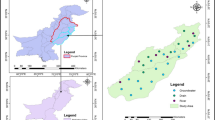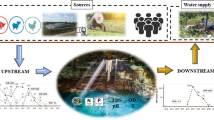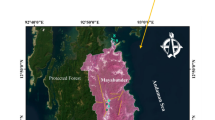Abstract
The aim of the study is to assess the evolving mine water quality of closed uranium mines (abandoned between 1958 and 1992) in the Czech Republic. This paper focuses on the changes in mine water quality over time and spatial variability. In 2010, systematic monitoring of mine water quality was performed at all available locations of previous uranium exploitation. Gravity flow discharges (mine adits, uncontrolled discharges) or shafts (in dynamic state or stagnating) were sampled. Since the quality of mine water results from multiple conditions—geology, type of sample, sampling depth, time since mine flooding, an assessment of mine water quality evolution was done taking into account all these conditions. Multivariate analyses were applied in order to identify the groups of samples based on their similarity. Evaluation of hydrogeochemical equilibrium and evolution of mine waters was done using the Geochemist’s Workbench and PHREEQC software. The sampling proved that uranium concentrations in mine waters did not predominantly exceed 0.45 mg/L. In case of discharges from old adits abandoned more than 40 years ago, uranium concentrations were below the MCL of US Environmental Protection Agency for uranium in drinking water (0.03 mg/L). Higher concentrations, up to 1.23 mg/L of U, were found only at active dewatered mines. Activity concentration of 226Ra varied from 0.03 up to 1.85 Bq/L except for two sites with increased background values due to rock formation (granites). Radium has a typically increasing trend after mine abandonment with a large variability. Concerning metals in mine water, Al, Co and Ni exceeded legislative limits on two sites with low pH waters. The mine water quality changes with a focus on uranium mobility were described from recently dewatered mines to shafts with water level maintained in order to prevent outflows to surface water and finally to stagnating shafts and discharges of mine water from old adits. The results were in good agreement with published experience on mine water stratification, its disturbance by pumping or natural water decant and the “first flush” phenomenon after mine flooding.





Similar content being viewed by others
References
Ames LL, McGarrah JE, Walker BA, Salter PF (1982) Sorption of uranium and cesium by Hanford basalts and associated secondary smectite. Chem Geol 35(3-4):205–225
Appelo CAJ, Postma D (eds) (2005) Geochemistry, groundwater and pollution, 2nd edn.. A. A. Balkema Publishers, Leiden
Arnold T, Zorn T, Bernhard G, Nitsche H (1998) Sorption of uranium(VI) onto phyllite. Chem Geol 151(1–4):129–141
Baborowski M, Bozau E (2006) Impact of former mining activities on the uranium distribution in the River Saale (Germany). Appl Geochem 21(6):1073–1082
Bain JG, Mayer KU, Blowes DW, Frind EO, Molson JWH, Kahnt R, Jenk U (2001) Modelling the closure-related geochemical evolution of groundwater at a former uranium mine. J Cont Hydr 52(1–4):109–135
Bernard JH, Pouba Z (1986) Ore deposits and metallogenesis of the Czechoslovak part of the Bohemian Massif. Nakladatelství ČSAV, Prague (in Czech)
Bethke CM (2007) Geochemical and biogeochemical reaction modeling, 2nd edn. Cambridge University Press, Cambridge
Bister S, Koenn F, Bunka M, Birkhan J, Lüllau T, Riebe B et al (2010) Uranium in water of the Mulde River. J Radio and Nucl Chem 286(2):367–372
Brůček P, Bican R, Klierova L, Vávrová L, Juhás D, Jandák R, Kollár K, Vacek J (2011) Report on monitoring results and state of environmental compounds of o.z. SUL in 2010. http://www.diamo.cz/images/stories/files/sul/zp_sul.pdf (in Czech) MS. Accessed 12 June 2012
Cairney T, Frost RC (1975) A case study of mine water quality deterioration, Mainsforth Colliery, County Durham. J Hydr 25(3–4):275–293
Carvalho FP, Madruga MJ, Reis MC, Alves JG, Oliveira JM, Gouveia J, Silva L (2007a) Radioactivity in the environment around past radium and uranium mining sites of Portugal. J Env Rad 96(1–3):39–46
Carvalho FP, Oliveira JM, Lopes I, Batista A (2007b) Radionuclides from past uranium mining in rivers of Portugal. J Env Rad 98(3):298–314
Chau ND, Nowak J, Bialic M, Rajchel L, Czop M, Wróblewski J (2011) Radiological hazard of mine water from polymetallic and uranium deposits in the Karkonosze Mountains, South-West Poland. New Uranium Min Boom. doi:10.1007/978-3-642-22122-4_88
Cressie NAC (1993) Statistics for spatial data—revised edition. Wiley, New York
ČSN 75 7614 (1998) Česká technická norma. Water quality—determination of uranium (in Czech). Český normalizační institut, Praha
ČSN EN ISO 17294–2 (2005) Technical norm. Jakost vod-Použití hmotnostní spektrometrie s indukčně vázaným plazmatem (ICP-MS)-Část 2: Stanovení 62 prvků. EAN code 8590963735641 (in Czech)
Decree No. 369/2004 Sb. Vyhláška o projektování, provádění a vyhodnocování geologických prací, oznamování rizikových geofaktorů a o postupu při výpočtu zásob výhradních ložisek. (in Czech)
Domenico PA, Schwartz FW (1998) Physical and chemical hydrogeology, 2nd edn. Wiley, New York
Fetter CW (1999) Contaminant hydrogeology, 2nd edn. Prentice Hall, New Jersey
Fetter CW (2001) Applied hydrogeology, 4th edn. Prentice Hall, New Jersey
Földing G, Szegvári G, Csővári M (2012) Hydrogeological evaluation of flooded uranium mine cavities in Hungary. New Uranium Min Boom. doi:10.1007/978-3-642-22122-4_36
Gebhart B, Jaluria Y, Mahajan RL, Sammmakia B (1988) Buoyancy-induced flows and transport. Springer, Berlin, pp 1–1001
Gzyl G, Banks D (2007) Verification of the “first flush” phenomenon in mine water from coal mines in the Upper Silesian Coal Basin, Poland. J Cont Hydr 92(1–2):66–86
Hájek A, Lusk K, Všetečka M and Veselý P (2006) Analysis of flooding the uranium mines in the Czech Republic. Archives of Diamo s. p 171 and suppls. (in Czech) MS
Johnson KL, Younger PL (2002) Hydrogeological and geochemical consequences of the abandonment of Frazer’s Grove carbonate hosted Pb/Zn fluorspar mine, North Pennines, UK. In: Younger PL, Robins NS (eds), Mine Water Hydr and Geoch. Geological Society, London, Special Publication 198: 347–364
Jolliffe IT (1986) Principal component analysis. Springer, New York
Kafka J, Aulický R, Ványi K, Kolek M, Kominek V, Kopecký P, Staněk V (eds) (2003) Ore and uranium mining of the Czech republic. Anagram, Ostrava (in Czech)
Kerry TB, MacQuarrie K, Mayer U (2005) Reactive transport modeling in fractured rock: a state-of-the-science review. Earth Sci Rev 72(3–4):189–227
Ladwig KJ, Erickson PM, Kleinmann RLP, Posluszny ET (1984) Stratification in water quality in inundated anthracite mines. Eastern Pennsylvania. US Bureau of Mines Report of Investigations RI-8837. US Bureau of Mines, Pittsburgh
Lozano JC, Vera TF, Gómez EV, Blanco RP (2000) Radiological characterization of a uranium mine with no mining activity. Appl Radiat Isot 53(1–2):337–343
Manly BFJ (1994) Multivariate statistical methods. A primer. Chapman & Hall, London
Meinrath A, Schneider P, Meinrath G (2003) Uranium ores and depleted uranium in the environment with a reference to uranium in the biosphere from the Erzgebirge/Sachsen, Germany. J Envi Rad 64(2–3):175–193
Meyer J, Jenk U (2010) Flooding of the Schlema-Alberoda uranium mines: aspects of the prognosis regarding the uranium concentration in flood waters. GeoSc Eng http://gse.vsb.cz 56(spec. issue 3):27–31
Michálek B, Grmela A (2010) Mine waters of the flooded uranium deposit in Olší. GeoScience Engineering. vyd. VŠB-TU Ostrava. HGF. 2010. 56(3):32–38
Michálek B, Hájek A, Rapantová N, Grmela A (2007) Research on mine waters of the uranium deposit of Olší-Drahonín. J Uhlí, Rudy, Geol průzk 14(12):11–15 (in Czech)
Neubauer L, Straková I et al (2011) Report on monitoring results and state of environmental compounds of o.z. TÚU in 2010. http://www.diamo.cz/images/stories/files/tuu/zp_tuu.pdf (in Czech) MS
Neves O, Matias MJ (2008) Assessment of groundwater quality and contamination problems ascribed to an abandoned uranium mine (Cunha Baixa region, Central Portugal). Environ Geol 53(8):1799–1810
Nuttall CA, Younger PL (2004) Hydrochemical stratification in flooded underground mines: an overlooked pitfall. J Cont Hydr 69(1–2):101–114
Parkhurst DL, Appelo CAJ (1999) User’s guide to PHREEQC—a computer program for speciation. batch—reaction. one dimensional transport. and inverse geochemical calculations. U. S. Geol. Surv.. Denver. Colorado. USA. [online] available on: http://water.usgs.gov/software. [cited 1. 3. 2012]
Rapantova N, Grmela A, Vojtek D, Halir J, Michalek B (2007) Groundwater flow modelling applications in mining hydrogeology. J Mine Water Environ 26(4):264–271
Rapantová N, Grmela A, Michálek B, Hájek A, Zábojník P, Zeman J (2008) Utilization of Olší-Drahonín uranium deposit after mine closure. 10th IMWA Congress. Mine Water and the Environment. Karlovy Vary. Proceedings ed. Rapantova & Hrkal. Printed Esmedia DTP s.r.o. Olomouc: 221–224.
Reimann C, Caritat P (1998) Chemical elements in the environment. Springer-Verlag, Berlin
US EPA (2011) National Primary Drinking Water Regulations. http://water.epa.gov/drink/contaminants/index.cfm. Accessed 12 June 2012
Váša J, Toman Z et al (2011) Report on monitoring results and state of environmental compounds of o.z. GEAM in 2010. http://www.diamo.cz/images/stories/files/geam/zp_geam.pdf (in Czech) MS
WHO (2011) Uranium in drinking water. Background document for development of WHO guidelines for drinking-water quality. WHO/SDE/WSH/03.04/118/Rev/1 http://www.who.int/.../uranium_forcomment_2011021
Wolkersdorfer Ch (1994) Changes in mine water hydrology during the flooding of an abandoned uranium mine in the Erzgebirge/Saxonia/Germany. Proc. 5th Int. Mine Water 8 ∼ 1UZ. Congress. Nottingham, 43–55
Wolkersdorfer C (1996) Hydrogeochemical investigations of an abandoned uranium mine in the Erzgebirge/Germany. Appl Geochem 11(1–2):237–241
Wolkersdorfer C (2008) Water management at abandoned flooded underground mines. Springer, Berlin
Yamamoto M, Sakaguchi A, Kofuji H (2010) Uranium in acidic mine drainage at the former Ogoya Mine in Ishikawa Prefecture of Japan. J Rad and Nuclear Chem 283(3):699–705
Younger PL (2000) Predicting temporal changes in total iron concentrations in grundwaters flowing from abandoned deep mines: a first approximation. J Contam Hydrol 44:47–69
Younger PL, Charlotte AN (2004) Hydrochemical stratification in flooded underground mines: an overlooked pitfall. J Cont Hydr 69(1–2):101–114
Younger PL, La Pierre AB (2000) ‘Uisge Me’inne’: mine water hydrogeology in the Celtic lands, from Kernow (Cornwall, UK) to Ceap Breattain (Cape Breton, Canada). In: Robins NS, Misstear BDR. (eds.) Groundwater in the Celtic Regions: studies in hard rock and Quaternary hydrogeology. Geological Society, London, Spec. Publ 182:35–52
Younger PL, Banwart SA, Hedin RS (2002) Mine water—hydrology, pollution, remediation. Kluwer, Dordrecht
Younger PL, Wolkersdorfer C, ERMITE Consortium (2004) Mining impacts on the freshwater environment: technical and managerial guidelines for catchment scale management. J Mine Water Environ 23(Supplement 1):2–80
Zeman J, Černík M, Šupíková I (2009) Dynamic model of long term geochemical evolution of mine water after mine closure and flooding. Water Institute of Southern Africa & International Mine Water Association: Proceedings. International Mine Water Conference. Pretoria (Document Transformation Technologies) 828–836
Acknowledgments
The article has been made in connection with project ICT CZ.1.05/2.1.00/03.0082 (Institute of Clean Technologies for Mining and Utilization of Raw Materials for Energy Use) supported by the European Union and from the means of state budget by the Ministry of Education, Youth and Sports. This research was also financially supported by the Czech Science Foundation (research project no. 105/09/0808).
Author information
Authors and Affiliations
Corresponding author
Additional information
Responsible editor: Stuart Simpson
Electronic supplementary material
Rights and permissions
About this article
Cite this article
Rapantova, N., Licbinska, M., Babka, O. et al. Impact of uranium mines closure and abandonment on groundwater quality. Environ Sci Pollut Res 20, 7590–7602 (2013). https://doi.org/10.1007/s11356-012-1340-z
Received:
Accepted:
Published:
Issue Date:
DOI: https://doi.org/10.1007/s11356-012-1340-z




